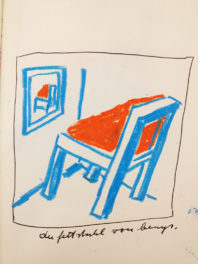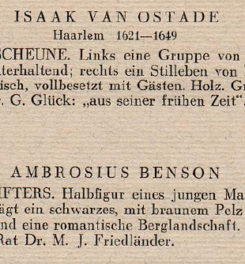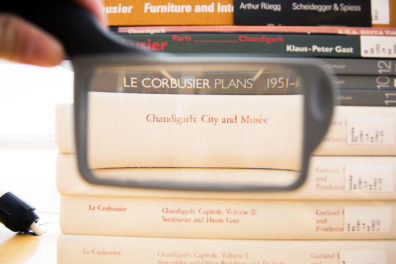In the depths of the Getty Research Institute, just above the vaults and below the library, a wall of outdated tube televisions sits tucked into the corner of an imaging lab. Stacked as high as the ceiling, they are the domain of conservator Jonathan Furmanski.
There are many archives in this country, but ones of the kind Furmanski oversees are rare. While many archivists are scrambling to learn the newest collection management software, Furmanski is romancing the obsolete: stuff like the portable turntable you finally convinced your father-in-law to sell on eBay, or the yellowing tape recorder that still smells like Camel cigarettes in your grandpa’s garage.
Furmanski collects and organizes gadgets like these in the Getty Research Institute for one simple reason: the items in modern collections, such as tapes from The Kitchen Archive or recordings from the Long Beach Museum of Art Video Archive, need the right machines to be heard, watched, or read. It’s Furmanski’s job to find the right technology to match a piece of ephemera or artwork, restore that artwork as much as possible using analog machines, and then digitize it so contemporary viewers can watch, listen, analyze, and write about it.
I joined Furmanski in his personal time capsule to learn more about his work.
Marissa Clifford: What does your job entail?
Jonathan Furmanski: I make digital surrogates, but I’m actively preserving and conserving materials in the act of doing so. I’m not merely making a facsimile of something like a photographer would.
MC: What is your background?
JF: I studied art and art history in college. I concentrated on performance art and contemporary art, but I also have experience with electrical engineering so I can do things like fix tape recorders.

Furmanski looks on at an analog original of performance artist Wolfgang Stoerchle in his lab at the Getty Research Institute. Photo: Tristan Bravinder
MC: How did you become a dealer in the obsolete?
JF: I started working here in conservation doing mount making and other conservation work. Around the same time, we had acquired the Long Beach Museum of Art Video Archive and the Allan Kaprow archive, and we began to acquire more modern technologies. I had both a good working knowledge of materials that are generally found on video and an understanding of those technological systems. So those two things came together to form this position—and led to this space. It was a pretty fun year, assembling what I thought would be the best preservation lab for audio visual materials that I could. Once the lab was instituted, more and more acquisitions came in because we were able to provide the proper care and feeding of such materials.
MC: Are there others like you?
JF: Other institutions have people tasked with similar responsibilities, but a lot of archives don’t have sufficient space or equipment, and so rely on outside vendors for digitization. We are lucky that we live in Los Angeles, as there are warehouses of old broadcast equipment and a lot of knowledgeable people here from the film and television industry. There more than a few former techs for the broadcast industry in my rolodex for keeping this [lab] going.
MC: What is unique about dealing with modern archival collections?
JF: Until they can be played back, audiovisual collections are invisible. They’re mute until they come to me. When they do, they arrive with a cataloger’s description taken from the box or label, which sometimes is incorrect. After I create the digital object from the collection, my coworker Holly [McGee, Digital A/V Assistant] then takes it and marries it back up with the metadata and puts it back into the archive server. During this process we are updating the content description as necessary.
One such example comes from working with the Allan Kaprow Archive. In it there was a work that was originally cataloged as another artist’s, but as I was looking at it I realized it had to be a Kaprow. Turns out [Kaprow’s] students had been recording his work and the cameraman’s name ended up on the reel. It just took me watching it to realize it was documentation of a Kaprow event that we didn’t realize had existed before.

Furmanski’s lab is outfitted with tools and meters that tell him about the quality and composition of archival films, indicating how much they need to be repaired before being digitized. Photo: Tristan Bravinder
MC: Why does it matter that we view this stuff on the equipment it was originally made to be viewed on?
JF: There’s just a difference in quality, like the aspect ratio of the monitor, for example. You can’t really show a work on a different screen and think it looks as it was intended to by the artist.
MC: Why not digitize the materials immediately?
JF: Transforming the video from a thick analog signal into just zeroes and ones is necessary for its survival, but there are things lost, like that rich phosphorescent glow. That’s why we try to use native instrumentation while it’s in its analog form to get it at its digital best. The goal is not to digitize first and repair later. In conservation, you want to stay true to the original format as much as possible.
MC: What are the challenges of working with obsolete technologies?
JF: We have a lot of half-inch open reel tape that was recorded in the early to mid 1970s, so I need use a cleaning machine a lot. Moisture starts degrading tape, and if you play it back without cleaning, the surface can drag, scrape and hurt the tape as well as the machine. Being one of the first personal video recording formats, there is a lot of unique material committed to open reel tape. It can take a whole day of work to get one half-hour tape cleaned and transferred, and it can be stressful when you know that content of that tape exists nowhere else in the world.

Furmanski holds up a reel of tape to be cleaned. Photo: Tristan Bravinder
MC: What are the rarest technologies or materials you work with? What about the most common?
JF: Our collections are so varied, it’s hard to predict what I’ll be working on next. We have boxes of obscure Dictaphone recordings from the 1950s alongside more familiar items like VHS tapes from the 1980s. Each format presents its own set of concerns for the lab.
Sometimes the most common formats can present the most problems. U-Matic tape, for example was very successful from the late 1970s into the 1990s but then went obsolete very quickly. So we’re stuck with all this stuff on obsolete technology, and the cost to move it has been so high in the past that archives like the Long Beach Video collection, that is primarily on U-Matic tape, was forced into hibernation. Now, we’re slowly working through the collection, year by year. Similarly, audiocassettes proliferate the collections because they were such a successful medium. Cassettes have a similar problem to the open reel video, in that it was such an easy technology to use, there are a lot of personal recordings that exist nowhere else.
MC: What are you working on right now?
JF: I’m working on some stuff by the video artist Gary Hill: sixty open reel tapes we acquired that constitute early works from the Woodstock Artist Collective. I think of these videos as an artist’s sketchbook, where he is working through ideas on tape. It’s clear he recorded over some of these things multiple times, so they’re like palimpsests. Each tape is like another page, and sometimes there are things that are scribbled over or that don’t belong to him. Working with these tapes is always really rewarding because there is a lot to unpack.
I’m also working on tapes from the Harald Szeemann archive. Luckily though, the Szeemann material are mostly VHS and much younger and less problematic than the Hill stuff. But each format has its own set of problems to solve. Being an international curator, many of these VHS tapes are formatted for European television systems, like PAL and SECAM.

Furmanski’s lab is outfitted with monitors, meters, and other tools to repair analog audio and video tape. Photo: Tristan Bravinder
MC: What is the future of your field?
JF: When a work is contingent on technology (unlike painting), future-proofing things is very problematic. Here, we’re basically kicking these videos down the road for five to ten years, migrating them onto digital files that will probably have to be migrated onto something else later on. I’m already going back and looking at stuff I did ten years ago and finding we need to update them. There is no shortage of opinions on the future of digital archiving, but most everyone agrees that we don’t have any choice but to digitize.





So, far, human record keeping has obtained three durable and long-lasting mediums for information storage.
Only two of our three are readily portable and those are Paper and Film. The durability of these media is substantial if kept under proper and controlled conditions.
The third medium, stone, wins the durability contest but completely fails the portability contest.
This archival-digital-storage thing may some day arrive at another durable medium for itself. If it does, it can happily join Paper, Film, and stone as reliably durable storage media for archival and long-term storage.
So far, digital storage appears to be reliably and unreliably durable over the short term.